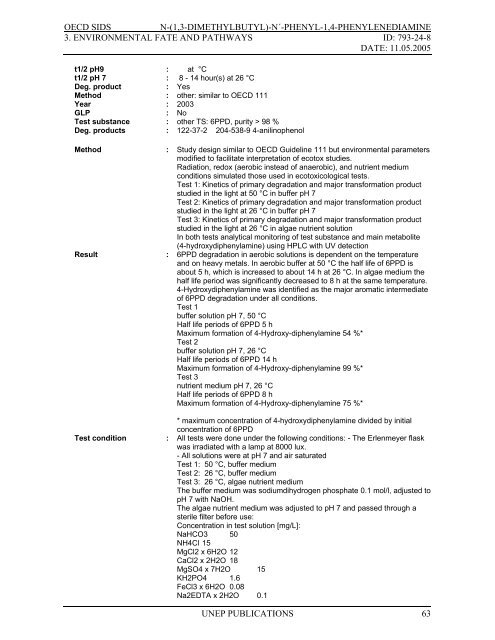N-(1,3-Dimethylbutyl)-N
N-(1,3-Dimethylbutyl)-N
N-(1,3-Dimethylbutyl)-N
Create successful ePaper yourself
Turn your PDF publications into a flip-book with our unique Google optimized e-Paper software.
OECD SIDS<br />
N-(1,3-DIMETHYLBUTYL)-N´-PHENYL-1,4-PHENYLENEDIAMINE<br />
3. ENVIRONMENTAL FATE AND PATHWAYS ID: 793-24-8<br />
DATE: 11.05.2005<br />
t1/2 pH9 : at °C<br />
t1/2 pH 7 : 8 - 14 hour(s) at 26 °C<br />
Deg. product : Yes<br />
Method : other: similar to OECD 111<br />
Year : 2003<br />
GLP : No<br />
Test substance : other TS: 6PPD, purity > 98 %<br />
Deg. products : 122-37-2 204-538-9 4-anilinophenol<br />
Method : Study design similar to OECD Guideline 111 but environmental parameters<br />
modified to facilitate interpretation of ecotox studies.<br />
Radiation, redox (aerobic instead of anaerobic), and nutrient medium<br />
conditions simulated those used in ecotoxicological tests.<br />
Test 1: Kinetics of primary degradation and major transformation product<br />
studied in the light at 50 °C in buffer pH 7<br />
Test 2: Kinetics of primary degradation and major transformation product<br />
studied in the light at 26 °C in buffer pH 7<br />
Test 3: Kinetics of primary degradation and major transformation product<br />
studied in the light at 26 °C in algae nutrient solution<br />
In both tests analytical monitoring of test substance and main metabolite<br />
(4-hydroxydiphenylamine) using HPLC with UV detection<br />
Result : 6PPD degradation in aerobic solutions is dependent on the temperature<br />
and on heavy metals. In aerobic buffer at 50 °C the half life of 6PPD is<br />
about 5 h, which is increased to about 14 h at 26 °C. In algae medium the<br />
half life period was significantly decreased to 8 h at the same temperature.<br />
4-Hydroxydiphenylamine was identified as the major aromatic intermediate<br />
of 6PPD degradation under all conditions.<br />
Test 1<br />
buffer solution pH 7, 50 °C<br />
Half life periods of 6PPD 5 h<br />
Maximum formation of 4-Hydroxy-diphenylamine 54 %*<br />
Test 2<br />
buffer solution pH 7, 26 °C<br />
Half life periods of 6PPD 14 h<br />
Maximum formation of 4-Hydroxy-diphenylamine 99 %*<br />
Test 3<br />
nutrient medium pH 7, 26 °C<br />
Half life periods of 6PPD 8 h<br />
Maximum formation of 4-Hydroxy-diphenylamine 75 %*<br />
* maximum concentration of 4-hydroxydiphenylamine divided by initial<br />
concentration of 6PPD<br />
Test condition : All tests were done under the following conditions: - The Erlenmeyer flask<br />
was irradiated with a lamp at 8000 lux.<br />
- All solutions were at pH 7 and air saturated<br />
Test 1: 50 °C, buffer medium<br />
Test 2: 26 °C, buffer medium<br />
Test 3: 26 °C, algae nutrient medium<br />
The buffer medium was sodiumdihydrogen phosphate 0.1 mol/l, adjusted to<br />
pH 7 with NaOH.<br />
The algae nutrient medium was adjusted to pH 7 and passed through a<br />
sterile filter before use:<br />
Concentration in test solution [mg/L]:<br />
NaHCO3 50<br />
NH4Cl 15<br />
MgCl2 x 6H2O 12<br />
CaCl2 x 2H2O 18<br />
MgSO4 x 7H2O 15<br />
KH2PO4 1.6<br />
FeCl3 x 6H2O 0.08<br />
Na2EDTA x 2H2O 0.1<br />
UNEP PUBLICATIONS 63
















